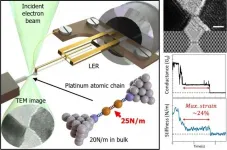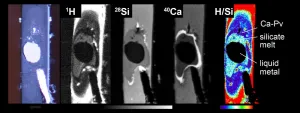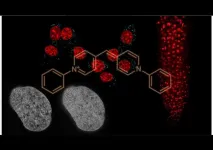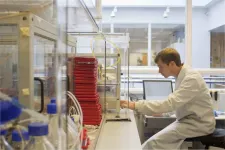(Press-News.org) Researchers at UC San Francisco have observed a new feature of neural activity in the hippocampus - the brain's memory hub - that may explain how this vital brain region combines a diverse range of inputs into a multi-layered memories that can later be recalled.
Using a special "micro-grid" recording device developed by colleagues at Lawrence Livermore National Laboratory (LLNL), the UCSF researchers were able to measure hippocampus activity in study participants undergoing surgery to treat severe epilepsy. They discovered that brain waves travel back and forth across this structure, integrating messages from different areas of the brain, and showed for the first time what scientists previously had only been able to hypothesize.
"Brain recordings are an important part of guiding epilepsy surgery," said Edward Chang, MD, PhD, chair of the Department of Neurological Surgery and the senior author on the study, which appears May 12 in Nature Communications. "The new high-density electrode grid technology used here allowed us to see a novel property of hippocampal activity that was previously unknown."
Chang specializes in treating epilepsy with brain surgery, during which the hippocampus, a long structure deep the brain within an area called the temporal lobe, is exposed and sometimes fully or partially removed. The hippocampus can be a source of seizures for people with epilepsy and is one of the first brain regions affected in Alzheimer's disease.
Previous studies had suggested that waves of activity in the hippocampus only travel in one direction: from the back end, which encodes most of the information about physical location, to the front, which encodes most emotional information. To Jon Kleen, MD, PhD, lead author on the study and assistant professor of neurology in the Weill Institute for Neurosciences, this one-way travel wasn't sufficient to explain how this small brain region manages to link multiple types of information to form a memory.
As an example, he said, imagine that you've lost your keys in Times Square. "You remember the spatial "where" aspect - Times Square - but you also remember the emotional feeling 'Ack, I lost my keys!'" he said. To process a memory, Kleen noted, there must be some way to integrate many parts of a memory together. To accomplish this, he surmised, it would make sense for brain waves to travel via multiple routes to process information.
Customized Electrode Array Gives Two-Dimensional View of Brain Waves
In an effort to test this hypothesis, Chang and Kleen partnered with Razi Haque, Implantable Microsystems Group Lead at LLNL, to develop a device that could give a high-resolution, two-dimensional picture of neural activity. Haque helped create a device smaller than a dime, containing 32 electrodes spaced 2 mm apart in a flexible polymer that could conform to the shape of the hippocampus.
During surgery, Chang gently laid the electrode array directly on the hippocampi of six different surgical patients to monitor electrical activity while the patients rested. Using algorithms such as machine learning to analyze the data, the team found that not only do brain waves travel both up and down the hippocampus, but that the directions they move can be predicted.
The team also found that at times, waves of two different frequencies would be present at once, moving in different directions and potentially carrying different information. The finding lends new insight into how the hippocampus can integrate information coming from multiple brain areas into detailed memories.
Wave Direction Changes with Cognitive Activity
Two of the patients were awake and interacting during surgery. Kleen was able to show them photos of common objects, such as a dog, and ask them to recall the word for it. Electrode data showed that while one patient was recalling the word, cycles of activity consistently traveled from the back of the hippocampus toward the front. Seconds later, the cycles of activity changed, traveling in the opposite direction. "The direction of wave travel may be a biomarker reflecting the cognitive process the patient is engaged in at that moment," Kleen said.
These initial observations are just the tip of the iceberg, he said. The next steps are to make observations with an even higher resolution set of electrodes and to observe neuronal activity in patients performing more complex cognitive tasks. Ultimately, he hopes the information gained could lead to treatments using deep brain stimulation to enhance the neurostimulator therapies that are showing great success in epilepsy.
"The goal of this research is to accelerate our understanding of how the hippocampus works, so that we can address the damage to it that we see in patients with epilepsy and Alzheimer's disease," Kleen said. "If we find that, in some patients, the waves don't travel in the proper way, we can design more sophisticated stimulation patterns that may be more effective at preventing seizures or restoring cognition."
INFORMATION:
Co-authors on the paper include Jason Chung and Kristin Sellers, PhD, from UCSF, as well as additional researchers from LLNL. The project was funded by NINDS grants R25NS070680 and K23NS110920 (J.K.); R01-DC012379, R00-NS065120, and partially funded by DARPA grant DP2-OD00862. For additional authors and funding, please see the paper.
About UCSF: The University of California, San Francisco (UCSF) is exclusively focused on the health sciences and is dedicated to promoting health worldwide through advanced biomedical research, graduate-level education in the life sciences and health professions, and excellence in patient care. UCSF Health, which serves as UCSF's primary academic medical center, includes top-ranked specialty hospitals and other clinical programs, and has affiliations throughout the Bay Area. UCSF School of Medicine also has a regional campus in Fresno. Learn more at ucsf.edu, or see our Fact Sheet.
Follow UCSF
ucsf.edu | Facebook.com/ucsf | YouTube.com/ucsf
The international scientific community agrees that the latest findings of an FAU research team will revolutionise the entire chemistry of magnesium. The research team have discovered magnesium, which usually has a double positive charge in chemical compounds, in the elemental zero-oxidation state. They have published their ground-breaking findings in the journal Nature.
In the periodic table of elements, magnesium (Mg) is a metal with low electronegativity, which means it does not easily attract electrons but easily loses both the electrons in its outer shell during chemical reactions. It therefore only exists in nature as a compound ...
Ishikawa, Japan - Today, many well-studied materials in various fields, such as electronics and catalysis, are close to reaching their practical limits. To further improve upon modern technology and outperform state-of-the-art devices, researchers looking for new functional materials have to push the boundaries and explore more extreme cases. A clear example of this is the study of low-dimensional materials, such as monoatomic layers (2D materials) and monoatomic chains (1D materials).
It has been proved time and time again that low-dimensional materials exhibit exotic properties that are absent in their 3D bulk counterparts. For example, monoatomic chains of metals like gold ...
High-temperature and high-pressure experiments involving a diamond anvil and chemicals to simulate the core of the young Earth demonstrate for the first time that hydrogen can bond strongly with iron in extreme conditions. This explains the presence of significant amounts of hydrogen in the Earth's core that arrived as water from bombardments billions of years ago.
Given the extreme depths, temperatures and pressures involved, we are not physically able to probe very far into the earth directly. So, in order to peer deep inside the Earth, researchers use techniques involving seismic data to ascertain things like composition and density of subterranean material. Something that has stood out for as long as these kinds of measurements have been taking place is that the core is primarily ...
The ease with which anyone can create online content for free, especially on social media, has led to superabundance of information being one of the defining characteristics of today's communication systems. This situation has resulted in increasingly intense competition for attention, which has become a scarce good. The researchers from the Complex Systems group (CoSIN3) at the UOC's Internet Interdisciplinary Institute (IN3) María José Palazzi and Albert Solé --professor at the Faculty of Computer Science, Multimedia and Telecommunications?--, led by Javier Borge, have participated in the design of ...
When it comes to ancient Roman imperial architecture, most people usually have a mental image of white marble statues, columns, or slabs. While it is true that many buildings and squares at that time were decorated with marble, it was frequently not white but colored marble that was employed, such as the green-veined Cipollino Verde, which was extracted on the Greek island of Euboea. Because marble was very expensive, it was often placed in thin slabs as a cladding over other, cheaper stones. "To date, however, no actual remains of marble workshops from the Roman imperial era have been found, so little is known about marble processing during this period," said Professor Cees Passchier ...
An international research team analyzed a database of more than 1000 supernova explosions and found that models for the expansion of the Universe best match the data when a new time dependent variation is introduced. If proven correct with future, higher-quality data from the Subaru Telescope and other observatories, these results could indicate still unknown physics working on the cosmic scale.
Edwin Hubble's observations over 90 years ago showing the expansion of the Universe remain a cornerstone of modern astrophysics. But when you get into the details ...
A group of scientists at Nagoya University, Japan, have developed an incredibly versatile DNA fluorescent dye, named 'Kakshine' after a former NU student of its members, Dr Kakishi Uno, but it also means to make the nucleus shine brightly, since the nucleus is pronounced 'Kaku' in Japanese. Dr Uno, with Dr Yoshikatsu Sato and Nagisa Sugimoto, the other two members of the research team at the Institute of Transformative Bio-Molecules (ITbM), succeeded in developing a DNA binding fluorescent dye with the pyrido cyanine backbone, which satisfied the three principal qualities required of such a dye - that it have high selectivity for DNA, ability to use visible light with limited phototoxicity, ...
A new method to analyse the blood thinning drug Heparin has been developed that can pinpoint contaminants more accurately and quickly, providing greater quality control and safety.
An interdisciplinary team from the University of Nottingham's Schools of Pharmacy and Medicine have used the latest chemical imaging technology to identify contaminants in Heparin at the nanoscale, a discovery that manufacturers could use to improve the quality and safety of this widely used anticoagulant drug. The research has been published in Communications Chemistry.
Heparin is naturally occurring glycosaminoglycan ...
ATS 2021, New York, NY - The use of e-cigarettes is associated with wheezing and shortness of breath in young adults and adolescents, even in those who don't smoke cigarettes or marijuana, according to research presented at the ATS 2021 International Conference.
Alayna P. Tackett, PhD, assistant professor of preventive medicine, University of Southern California Keck School of Medicine, and colleagues conducted a web-based survey of 2,931 adolescents and young adults (average age: 18.9) with questions on the use of e-cigarettes, cigarettes and cannabis, along with self-reported asthma diagnosis and respiratory symptoms, over the previous 30 days. The survey was fielded between August 6 and 30, 2020 among a national convenience sample of youth and young ...
ATS 2021, New York, NY - Individuals with asthma who live in redlined neighborhoods have worse lung function than those in locales that excluded Black people and benefited from decades of inequitable wealth accumulation at the expense of Black communities in the United States, according to research presented at the ATS 2021 International Conference.
Alexander Schuyler, MD/PhD candidate, University of Pittsburgh School of Medicine, and Sally Wenzel, MD, director, Asthma & Environmental Lung Health Institute, University of Pittsburgh Medical Center, sought to examine the connection between residence in historically ...





